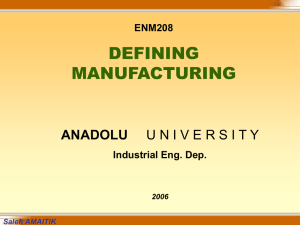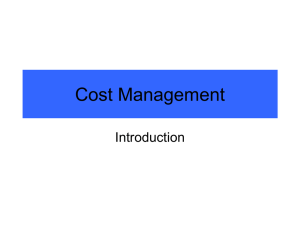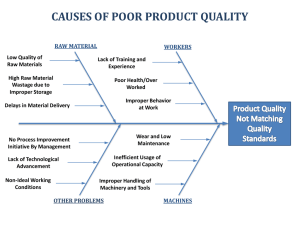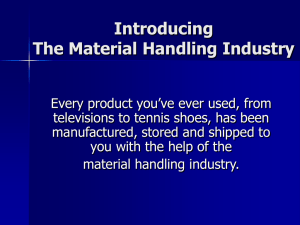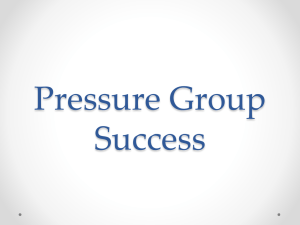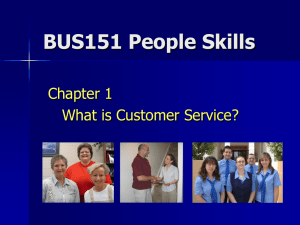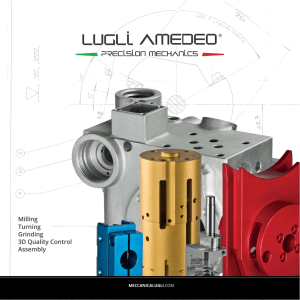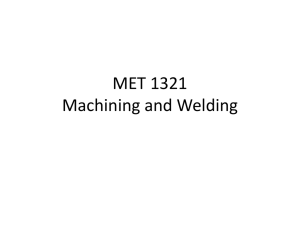Spring 2005 Design and Manufacturing process
advertisement
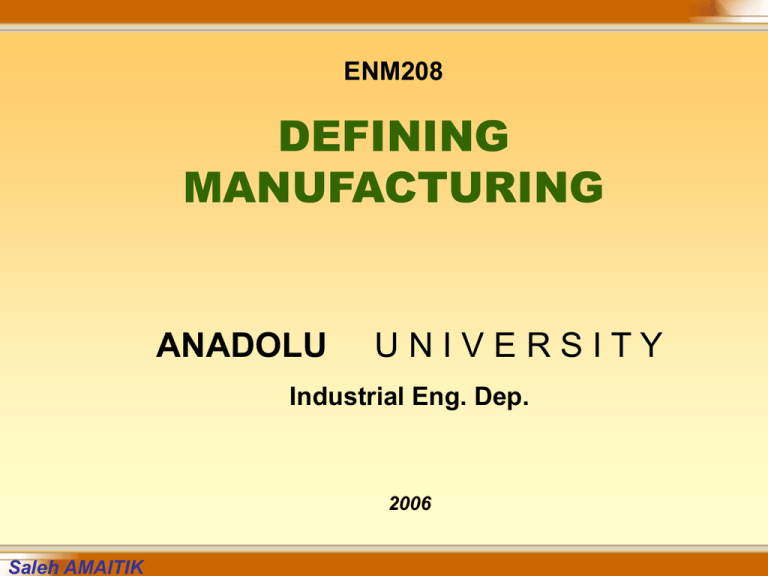
ENM208 DEFINING MANUFACTURING ANADOLU UNIVERSITY Industrial Eng. Dep. 2006 Saleh AMAITIK Manufacturing Processes Defining Manufacturing The word manufacturing is defined from the Latin manu factus made by hand manu = hand factus = made Spring 2005 Manufacturing Processes Defining Manufacturing Manufacturing involves making products from raw materials by means of various processes, machinery, and operations, through a well-organized plan for each activity required. Spring 2005 Manufacturing Processes Defining Manufacturing Production Manufacturing Manufacturing Engineering is the term used widely in the United States to describe this area of industrial activity. Production Engineering is equivalent term to manufacturing Engineering in other countries. Spring 2005 Manufacturing Processes Manufacturing Systems The manufacturing System is a collection of manufacturing processes used to obtain a desired product(s) The manufacturing System is the design arrangement of the manufacturing processes. or Control of a manufacturing system applies to overall control of the whole processes or equipment. The entire manufacturing system must be controlled in order to schedule and control production, inventory levels, product quality and so forth. Spring 2005 Manufacturing Processes Manufacturing Systems The manufacturing System takes inputs produces products for the external customer Spring 2005 and Manufacturing Processes Manufacturing Systems Manufacturing System may produce Discrete products Individual parts (e.g. nails, gears, engine blocks, ……etc.) Continuous products May be cut into individual pieces and thus become discrete parts (e.g. a spool of wire, metal or plastic sheets, tubes , ……etc.) Spring 2005 Manufacturing Processes Production Systems A production system, or the enterprise, will refer to the total company and will include with it the manufacturing system. The production system includes the manufacturing system plus all the other functional areas of the plant for information, design, analysis, and control. These subsystems are connected by various means to each other to produce products(s). Spring 2005 Manufacturing Processes Production Systems Manufacturing System (where value is added) Spring 2005 Manufacturing Processes Production Systems Production Types Low-quantity production (1 ~ 100 units/yr) Job shop, prototyping. Medium-quantity production (100 ~ 10,000 units/yr) Batch production & cellular manufacturing. High-quantity production (> 10,000 units/yr) Mass production. Spring 2005 Manufacturing Processes Machine A specific piece of equipment designed to accomplish specific processes, often called a Machine Tool Examples: Milling machine, punch press, …. Machine tools linked together to make a manufacturing system cell Spring 2005 Manufacturing Processes Job (Station) A collection of operations done on machines or a collection of tasks performed by one worker at one location on the assembly line. Examples: Machining, inspection, final assembly, …… Spring 2005 Manufacturing Processes Operation (Process) A specific action or treatment, often done on a machine, the collection of which makes up the job of a worker. Examples: Drilling, Forming, Welding, assembly, …… Spring 2005 Manufacturing Processes Tool Refers to the implements used to hold, cut, shape, or deform the work materials. Examples: Cutting tools in machining. Jigs and fixtures in work holding. Punches and dies in metal forming. Spring 2005 Manufacturing Processes Design and Manufacturing process Spring 2005 Manufacturing Processes Concurrent Engineering Concurrent engineering is a systematic approach to the integrated, concurrent design of products and their related processes, including manufacture and support. Spring 2005 Manufacturing Processes Design for Manufacturing (DFM) It is a comprehensive approach to production of products, ant it integrates the design process with materials, manufacturing methods, process planning, assembly, and quality assurance. Implements design for manufacture requires that designers have a fundamental understanding of the characteristics, capabilities, and limitations of materials, manufacturing processes and related operations, machinery and equipment. Spring 2005 Manufacturing Processes Selecting materials for manufacturing Variety of materials is now available, each having its own properties, applications, advantages, and limitations. Spring 2005 Manufacturing Processes Selecting materials for manufacturing When selecting materials for products, we consider Mechanical properties of materials (Strength, toughness, ductility, hardness, elasticity, fatigues, creep, ……( Physical properties of materials (density, specific heat, thermal expansion and conductivity, melting point, and electrical and magnetic properties, ……) Chemical properties of materials (corrosion, toxicity, flammability, ……) Spring 2005 Manufacturing Processes Selecting materials for manufacturing The material properties specified for a product should be appropriate to the conditions under which the product is expected to function. The manufacturing properties of materials determine whether they can be cast, formed, machined, welded, and heated-treated with relative ease. Spring 2005 Manufacturing Processes Selection of manufacturing processes Many processes are used to produce parts and shapes and there is usually more than one method of manufacturing a part from a given material Classification of manufacturing processes Machining (turning, drilling, milling, grinding, ……. Forming and shaping (rolling, forging, sheet forming,….. Casting (expendable mold, permanent mold, ……) Joining (welding, brazing, soldering, ….) Finishing (honing, polishing, coating, heat treatment, … Spring 2005 Manufacturing Processes Characterizing a manufacturing process Spring 2005 Manufacturing Processes Factors affecting the selection of manufacturing processes There are many factors which affect the selection of a suitable manufacturing process for a part. These factors are: • Geometry • Quality • Quantity • Material • Machine or equipment avalibility • Cost Spring 2005 Manufacturing Processes Factors affecting the selection of manufacturing processes Geometry Cylindrical, conical, and screw threads are mostly easily produced on a Lathe. Plane surface, block shapes and slots are generally produced by shaping, planning or milling. More complex parts may need to be cast, forged or shaped before machining. The shape of a part will decide the process which must be used to produce that part. Spring 2005 Manufacturing Processes Factors affecting the selection of manufacturing processes Quality Dimensional accuracy (tolerances). Geometrical accuracy. Surface finish. An appropriate manufacturing process should provide suitable dimensional accuracy, geometrical accuracy, and surface finish. Spring 2005 Manufacturing Processes Factors affecting the selection of manufacturing processes Quantity The quantity (batch size) determines the economics of manufacturing process selection. The cost falls as the batch size increases and more productive techniques can be employed. Spring 2005 Manufacturing Processes Factors affecting the selection of manufacturing processes Material The material from which the part is going to be made The material specified by the designer influences the method of manufacturing. Spring 2005 Manufacturing Processes Factors affecting the selection of manufacturing processes Machine or equipment availability Availability of machines and equipment and of operating experience with the manufacturing facility Cost Operational and manufacturing cost. Spring 2005 Manufacturing Processes Consequences of improper selection of materials and processes Numerous examples of product failure can be traced to Improper selection of material. Improper selection of manufacturing processes. Improper control of process variables. A part is generally considered to have failed when It stops functioning (e.g. broken shaft, gear, ….) It does not functioning properly or perform within required specification limits (e.g. worn bearing, …) It becomes unreliable or unsafe for further use (e.g. crack in a shaft, ..) Spring 2005 Manufacturing Processes Net-shape Manufacturing Since not all manufacturing operations produce finished parts, additional operations may be necessary. Net-shape or near-net-shape manufacturing. The part is made, in the first operation, as close to the final desired dimensions, tolerances, surface finish, and specifications as possible. Spring 2005 Manufacturing Processes Manufacturing Automation The major goals of automation in manufacturing facilities are to integrate various operations so as to improve productivity, to increase product quality, to minimize cycle times, and to reduce labor costs Computers are now used in a very broad range of applications including: Control and optimization of manufacturing processes. Material handling Automated assembly Automated inspection and testing of products Spring 2005 Manufacturing Processes Computer Integrated Manufacturing - CIM Spring 2005 Manufacturing Processes Computer Integrated Manufacturing - CIM Spring 2005 Manufacturing Processes Computer application in Manufacturing The following is an outline of the major applications of computers in manufacturing. Computer Numerical Control - CNC Computer Aided Process Planning - CAPP Automated and Robotic assembly systems. Flexible Manufacturing Systems - FMS Automated handling of materials. Artificial Intelligence. Spring 2005
